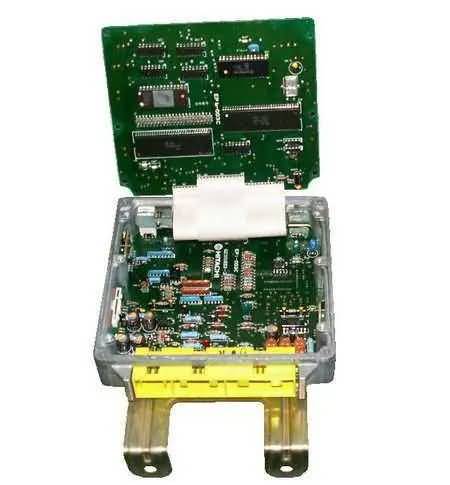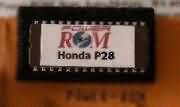Suzuki Swift GT Chip Installation
For installing a performance chip on your 1989-1994 Suzuki Swift GT/GTi ECU, just follow these instructions:
Start out by locating the engine computer on your car. It is located under the driver’s side lower dash panel. You will need to remove the bolts that are attaching the ECM on its place, then carefully pull out the ECU connector by pressing the locking plastic clips on it. See the drawing below for reference on locating the ECU:

Once the ECU computer is out, remove the top cover by taking out the 4 long bolts that secure its top and bottom metal covers. Now, remove the 6 bolts that hold the top circuit board. You will notice them as soon as you remove the top cover. The picture below will show the location of the 6 bolts that need to be removed.

DO NOT pull up the circuit board just yet! Please, first notice that this board is attached to the bottom board with a flexible ribbon connector. Flip out the top board very carefully, not to break the flexible ribbon. Look at the following picture, so you have an idea of the location of the flexible ribbon connector:

Now, the chip to be replaced, is on the top board and will be covered with a silver-colored label or sticker unless it has been previously replaced. First, notice the orientation of Pin #1. Write it down if necessary, as pin #1 of the new chip must be installed in the same orientation.
Being very careful not to damage the circuit by overheating, desolder the chip and then clean up the excess solder and flux in the circuit board. For cleaning excess solder, you may use desoldering braid and for cleaning the flux, you may use isopropyl alcohol (91%-99% solution recommended).
Now, a 28-pin DIL socket must be inserted and soldered where the chip was soldered, but before you do this, you should check the circuit area for broken copper traces, solder bridges or any other potential problems. Solder the 28-pin DIL socket and then insert the chip on the socket, aligning it in the same way the previous chip was installed. Do this by aligning all the pins of the chip into their corresponding holes on the socket, then firmly pressing down the chip or by gently tapping on top of the chip.

Note: The socket can be inserted in any of two ways, but it will be helpful if you install it with the mark for pin#1 pointing to the mark of pin#1 in the circuit board. That way, it can be used as a reference when swapping chips at any time.
When you finish installing the chip, put back the circuit board with its screws and the computer top and bottom covers with the long bolts. Reinstall the ECU computer in the car and make sure that the connector harnesses snap in place all the way in when you push it. Otherwise, some wires might not connect properly causing intermittent or erratic problems.
Interested in the full wiring diagram of the ECU connections of the 1992-1994 Suzuki Swift GT 1.3L?
(ALWAYS check your SPAM folder in case that you don't see the download in your inbox.)
Your information is safe with us. We take privacy seriously and DO NOT sell or share your information in any way.
Your data will only be used for sending the requested document(s) and for emailing any related information or material that we might offer in any future. If we do so, you will always be provided with a link for unsubscribing if you desire to do so.
A word of caution when using performance chips. There are many sellers offering low-quality performance chips or doing false claims of what the chip can do. For example, a chip that we have seen on a famous online market, the seller stated that it works on 1989-1995 models, which is incorrect. Some chips work on the 1989-1991 models, while some others work in the 1992-1994 models. The performance chip in the link below works in 1989 to 1994 models and brings a nice extra power to your car’s engine. Also, please do not believe the lies about a performance chip boosting horsepower up from +20hp to +50hp or even more.
A very good performance chip will be able to boost your engine’s horsepower from +5hp to around +12hp. That is what the good performance chip in the link below does. Once you try one of these, you won’t want to drive your car without it ever again!
Suzuki Swift GTi Performance Rally Chip














yay finally a site tht has a detailed install for gti chips woot!!! thx very much for the write up helped me heaps with my new stage 3 chip 😀 2nd fastest gti in aus mwahahaha lol
My suzuki swift 15plate every now and again refuses to start, it will bump start then after leaving it for a few hours it will start again, until the next time! Any ideas or solutions please. Diagnostic shows no fault on the car. It is very unreliable.
Hello Heather.
I am not aware of common problems of the Swift resembling what you described and a diagnostic must be done.
For example, when it does not start, does it crank? I mean, can you hear the starter motor spinning when you try to start the car?
If it is not, it can be simple things like an intermittent connection in the battery terminals, a loose ground from the battery, the ignition lock switch (the switch that makes contact when you turn the key), the starter itself, a faulty aftermarket alarm system that has a starter-kill switch, or anything else that is preventing the starter from doing its job.
If on the other hand, the starter spins but no start, then it can be a little more complicated like an immobilizer system that needs programming (the original programming got corrupted somehow), the ECM (Engine Control Module, a.k.a ECU or “engine computer”), an aftermarket alarm system that is faulty, a bad fuel pump, a dirty or defective flowmeter (if it is fuel injected, not carburated, as the year was not mentioned), the ignition coil(s), among other things. You see, when the engine spins but does not start, assuming that the engine is mechanically good, and I asume that because you mentioned that in occasions it starts and runs well, it is about two things, fuel delivery and ignition. Most of the time in these cases, one of those, or both, are absent.
That is why a diagnostic is needed. Depending on if the starter spins or not. Several checks must be done to pinpoint the problem, like if fuel is being injected, if yes, measuring the fuel rail pressure, checking if ignition is firing, etc. An engine scanner must be used but also some simple methods can be used for some of those, like injecting a small amount of fuel into the throttle to see if the problem is fuel delivery, checking the spark plugs and detecting how are they burning fuel, if too sooty it means too much fuel, low air, on the other hand, if they are whitish, then the contrary, which is problems with fuel delivery, etc.
Best wishes